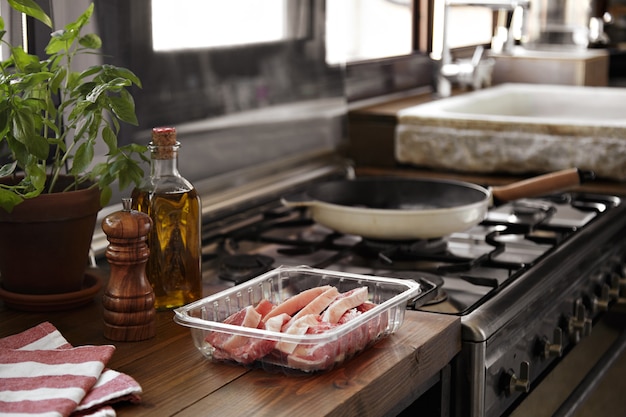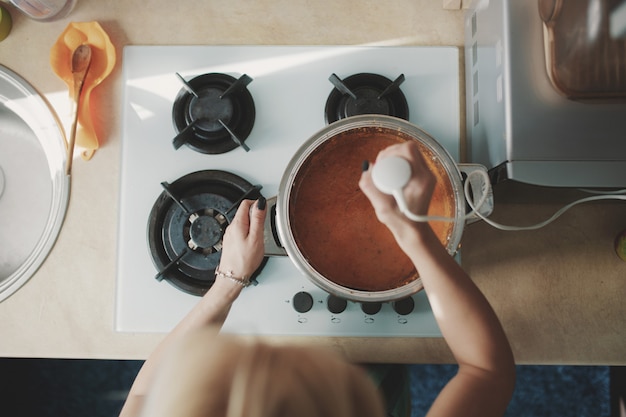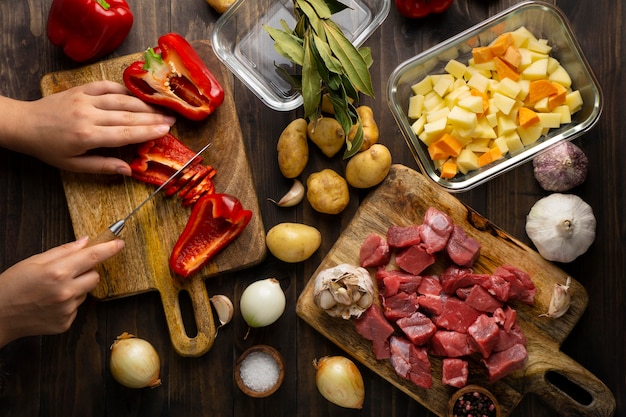Alright, let's talk gizzards. I know, I know, not everyone's first choice. But trust me, these little bundles of chewy, meaty goodness are a real treat when cooked right. They're incredibly versatile too! You can chuck them in a stew, add them to a stir-fry, or even make them the star of the show.
However, cooking gizzards isn't just a simple "throw-it-in-the-pan" affair. It takes a bit of know-how, and that's where I come in. Consider this your ultimate guide to conquering the art of stovetop gizzard cooking. I'll walk you through every step, from prep to plate, sharing my tips and tricks along the way.
So, grab your apron, sharpen those knives, and let's dive in!
(Part 1) The Gizzard Game: Getting Started

Choosing Your Gizzards - It's All About Quality
First things first: picking your gizzards. They're usually found in the poultry section of your local supermarket. Look for gizzards that are firm, plump, and free of any unpleasant smells. They should have a nice, fresh, almost "meaty" aroma.
Personally, I always go for fresh gizzards. The texture and flavor are just that little bit better. But if fresh ones aren't available, frozen ones will do the trick. Just make sure to defrost them thoroughly in the fridge overnight before you start cooking.
Prep Time: Getting Ready for the Stovetop
Once you've got your gizzards, it's time for a bit of prep work. Don't worry, it's not too complicated. Start by giving them a good rinse under cold water. Then, pat them dry with paper towels to get rid of any excess moisture.
Next, comes the trimming. I find a good pair of kitchen shears works best for this. Trim away any excess fat or gristle you find. You're looking for a clean, smooth surface. Once you've tidied them up, you're ready to move on to the fun part!
(Part 2) A World of Flavours: Seasoning Your Gizzards

Now, this is where you get to add your own personal touch! I like to keep things simple with a good sprinkle of salt and pepper. But you can get creative here. Some folks love to use paprika, garlic powder, onion powder, or even a bit of chili powder. It really depends on the flavour profile you're going for.
Here are a few flavour combinations I've found to work really well:
- Classic: Salt, pepper, and a dash of paprika. This is a great starting point for anyone who wants a simple and delicious gizzard dish.
- Spicy: Chili powder, cumin, and a pinch of cayenne pepper. This is a great option for those who like a bit of heat in their food.
- Mediterranean: Dried oregano, thyme, garlic powder, and a pinch of lemon zest. This combination adds a bright and tangy flavour to the gizzards.
Remember, the key is to season generously! You want the flavour to really penetrate those gizzards and create a delicious, well-seasoned dish.
(Part 3) The Stovetop Showdown: cooking techniques

Now for the cooking! There are a few different techniques you can use to cook gizzards on the stovetop, each with its own unique benefits. Let's explore them in detail:
Pan-Frying for Crispy Perfection
For a crispy exterior and juicy interior, pan-frying is the way to go. It's a quick and easy method, perfect for weeknight dinners. Here's how to do it:
1. Heat your pan: Start by heating a generous amount of oil in a large skillet over medium-high heat. You want the oil to be hot enough to sizzle when you add the gizzards.
2. Add the gizzards: Once the oil is hot, carefully add the gizzards to the pan. Make sure they're not overcrowded! Give them space to cook evenly on all sides.
3. Cook them up: Cook the gizzards for about 5-7 minutes on each side, or until they're golden brown and cooked through. Don't be afraid to flip them! You want to make sure all sides are cooked properly.
4. Keep an eye on the heat: If they start to brown too quickly, reduce the heat slightly to prevent burning.
Braising for Tender and Flavorful Gizzards
If you're looking for a more tender and flavorful gizzard, braising is the way to go. It's a slow and gentle cooking method that allows the gizzards to become incredibly tender and absorb the flavors of the braising liquid. Here's how to braise gizzards:
1. Brown the gizzards: Start by browning the gizzards in a large pot over medium heat. This helps to develop a rich flavor and a crispy exterior.
2. Add your braising liquid: Once the gizzards are browned, add your favorite braising liquid. I love using a combination of beef broth, red wine, and some fresh herbs. You can also use chicken broth, vegetable broth, or even a combination of different liquids.
3. Simmer gently: Once the liquid is simmering, reduce the heat to low, cover the pot, and let the gizzards simmer gently for at least an hour, or until they are fork-tender.
Slow-Cooking for Maximum Tenderness
If you have a slow cooker, you can't go wrong with this method. It's hands-off, foolproof, and produces incredibly tender gizzards. Here's how to slow-cook gizzards:
1. Add the gizzards: Place the gizzards in the slow cooker.
2. Add the braising liquid: Pour in your favorite braising liquid, along with your chosen seasonings.
3. Cook on low: Set the slow cooker to low and cook for 6-8 hours, or until the gizzards are fall-apart tender.
(Part 4) The Final Touches: Garnishing and Serving
Now that your gizzards are cooked to perfection, it's time to add some finishing touches. You can serve them as is, but a few garnishes can really elevate the dish.
Here are some ideas:
- Fresh herbs: Parsley, cilantro, chives, or basil all work beautifully with gizzards. They add a fresh, vibrant touch.
- Lemon zest: A dash of lemon zest adds a bright and tangy flavor that cuts through the richness of the gizzards.
- Hot sauce: For those who like a little heat, a few drops of hot sauce can add a kick to the dish.
- Roasted garlic cloves: A few roasted garlic cloves can add a rich and savory flavor.
As for serving, the possibilities are endless! You can serve gizzards on a bed of rice, mashed potatoes, or even a simple salad. Or, you can use them as a topping for sandwiches, tacos, or salads. You can even serve them as part of a larger platter with other dishes.
(Part 5) The Gizzard Chronicles: My Personal Experiences
When I first started cooking gizzards, I was a bit intimidated. I wasn't sure what to expect, and I was worried I'd mess it up. But you know what? It turned out to be a lot easier than I thought.
My first attempt was a simple pan-fried gizzard with a sprinkle of salt and pepper. It was surprisingly good! The texture was chewy and satisfying, and the flavor was rich and meaty. It reminded me of a more intense version of chicken, with a deeper, more savory flavour that I really enjoyed.
Since then, I've experimented with different flavor combinations, cooking methods, and serving styles. I've even tried making gizzard stew, gizzard skewers, and even gizzard salad. And let me tell you, each one has been a delicious adventure!
(Part 6) The Gizzard Debate: A Culinary Conundrum
I know, I know. Gizzards are not for everyone. Some people find them to be a bit too chewy or a bit too gamey. But for those who are adventurous and open-minded, gizzards are a real culinary treasure.
They're packed with protein and iron, and they're a great source of other essential nutrients. Plus, they're a surprisingly versatile ingredient that can be cooked in so many different ways.
So, if you're looking for a new culinary adventure, I encourage you to give gizzards a try. You might just be surprised at how much you enjoy them!
(Part 7) Gizzards Around the World: A Global Perspective
Gizzards are a popular ingredient in many cultures around the world. In the United States, they're often used in Southern cooking, where they're a staple ingredient in dishes like gizzards and gravy. They're also a staple ingredient in many Asian cuisines, where they're often stir-fried or added to soups and stews.
Here are some examples of popular gizzard dishes from around the world:
| Region | Dish | Description |
|---|---|---|
| Southern United States | Gizzards and Gravy | A classic southern comfort food consisting of pan-fried gizzards served over mashed potatoes and smothered in a creamy gravy. |
| China | La Zi Ji (Spicy Chicken) | A popular Sichuan dish that often includes gizzards, chicken, and other ingredients. It's known for its spicy and flavorful sauce. |
| Philippines | Adobo | A Filipino national dish that often includes gizzards, chicken, pork, and vegetables. It's cooked in a soy sauce, vinegar, and garlic marinade. |
(Part 8) Beyond the Stovetop: Exploring Other Cooking Methods
While stovetop cooking is a great way to prepare gizzards, there are other methods you can try. Here are a few of my favourites:
- Grilling: Grilling gizzards gives them a smoky flavor and a crispy texture. Just be sure to grill them over medium heat and cook them for about 5-7 minutes on each side, or until they're cooked through. For added flavor, try marinating them before grilling.
- Roasting: Roasting gizzards is a great option if you're looking for a hands-off cooking method. Simply toss the gizzards with your favorite seasonings and roast them in a preheated oven at 400°F for 30-40 minutes, or until they're cooked through.
- Air-frying: Air-frying gizzards is a quick and easy way to achieve a crispy texture. Simply toss them with your favorite seasonings and air-fry them at 400°F for 10-12 minutes, or until they're cooked through.
(Part 9) The Gizzard Journey: Storage and Leftovers
Once your gizzards are cooked, you can store them in the refrigerator for up to 3 days. Just make sure to store them in an airtight container to keep them fresh and prevent them from absorbing other flavors in your fridge.
If you have leftover gizzards, don't throw them away! They can be used in a variety of ways. Here are a few ideas:
- Salads: Chop up the gizzards and add them to your favorite salad for a protein boost and a unique flavor.
- Soups and stews: Add leftover gizzards to soups and stews for a hearty and flavorful meal.
- Sandwiches: Dice the gizzards and add them to your sandwiches for a more substantial and flavorful filling.
- Dip or spread: You can also make a delicious gizzard dip or spread. Simply chop the gizzards finely and mix them with your favorite cream cheese, mayonnaise, or other spreadable ingredients.
FAQs
1. What do gizzards taste like?
Gizzards have a chewy texture and a rich, meaty flavor. They're a bit more intense than chicken, with a deeper, more savory flavor. Some people compare them to a more flavorful version of chicken liver. The flavor can vary depending on how the gizzards are cooked, but they generally have a distinct, savory taste.
2. How do you know when gizzards are cooked?
Gizzards are cooked when they are no longer pink inside and have a firm texture. You can also use a meat thermometer to check the internal temperature. They should reach an internal temperature of 165°F.
3. Can you freeze gizzards?
Yes, you can freeze gizzards. They can be frozen for up to 3 months. Just make sure to freeze them in an airtight container or freezer bag. Freezing gizzards is a great way to preserve them for later use. Make sure to thaw them in the refrigerator overnight before cooking.
4. Can you eat gizzards raw?
No, you should not eat gizzards raw. They can contain harmful bacteria that can make you sick. It's essential to cook them thoroughly to ensure that they're safe to eat.
5. What are some good recipes for gizzards?
There are many great recipes for gizzards. Some popular options include gizzards and gravy, gizzard stew, gizzard skewers, and gizzard salad. You can find many recipes online or in cookbooks.
So, there you have it! My ultimate guide to cooking gizzards on the stovetop. Now, go out there and get cooking! Who knows, you might just discover a new culinary passion. Happy gizzarding!
Everyone is watching

Perfect Rice Every Time: The Ultimate Guide to Cooking Rice
Cooking TipsAs a self-proclaimed foodie, I've always been a bit obsessed with rice. It's the foundation of countless cuisi...

Ultimate Guide to Cooking the Perfect Thanksgiving Turkey
Cooking TipsThanksgiving. Just the word conjures up images of overflowing tables laden with delicious food, the scent of r...

The Ultimate Guide to Cooking Asparagus: Tips, Techniques, and Recipes
Cooking TipsAsparagus. The mere mention of this spring delicacy conjures up images of vibrant green spears, crisp and burs...

Can You Cook Spaghetti with Gasoline? (The Shocking Truth)
Cooking TipsWe've all seen those crazy internet trends. You know, the ones that make you wonder, "Did someone actually try...

Chorizo and Eggs Recipe: The Ultimate Guide
Cooking TipsRight, let’s talk about chorizo and eggs. You know, that classic Spanish dish that's always a winner. It's th...
